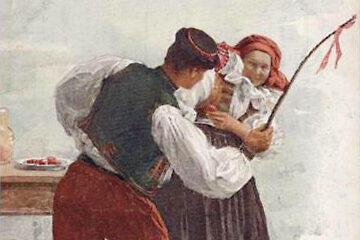At first I mistook the Slovak name for Easter to be a reference to the time change in March. “Veľká Noc” literally translates to “big night” and—in what I still believe to be rather solid logic—I made a connection between that translation and our yearly extra hour of sleep.
However, I wasn’t long after the time change passed when I noticed that everyone was, suspiciously, still talking about this “Veľká Noc”. A quick online check corrected my error and refreshed me on the Slovak Easter traditions I had read about before coming on exchange.
Easter Weekend in my host family began on “Zelený štvrtok”. Green Thursday (as it translates to English) is a take on the Catholic holiday of “Maundy” or “Holy Thursday”, unique to Slovakia and the Czech Republic. It is customary to eat, predominately or exclusively, green vegetables on this day. The tradition amused me to no end, because for my current host family (and just about every Slovak family I know) Green Thursday seems to be the only day of the year they eat green vegetables. So momentously rare an effort is their consumption in Slovak culture, they had to make a holiday exclusively for it.
Slovakia has for centuries been a Catholic country and, as with Zelený štvrtok, most Easter traditions here reflect that. Families travel far and wide to be with their relatives over the entire holiday, church services run everyday and nearly every business in the town goes dark while the country celebrates. I spent most of the weekend with one of my exchange friends, Antoine. He came and dined with my host family in our village of Štôla, then I joined him in Poprad and stayed with his family overnight. The next day we hiked in the Tatras and then lunched at his host grandmother’s. Our stay in Poprad, however, had long been planned for a very specific purpose. The following day, the Monday after Easter, boasts a unique Slovak tradition, and one that has inspired a lot of controversy.
Antonie, another exchange student, Daniel, and I rose in the morning and walked to our exchange coordinator’s house. There, my two companions, with a bottle of water and traditional willow branch switches in hand, greeted our friend, the coordinator’s daughter, Karolína, by splashing her and lightly whipping her with the switches. This old Slovak tradition once was meant to encourage beauty, health and fertility in the young, single women of the village. Tradition accordingly states that women should be grateful for this—that it is a compliment—and they are expected to give the men chocolate and an invitation to eat with the family.
Many claim that this tradition is misogynistic and, at its very origins, it is. That said, the actual perception and practice by Slovaks must be examined before the tradition can be judged. The most extreme observation of this tradition is carried out only in small villages with a connection to their past. There, women are restrained by the men, both genders dressed in folk costume, while buckets of water are poured over the females’ heads. This sounds extreme, but the people involved are almost performers and it isn’t done without prior planning—consent, if you will. It is part of Slovak history and I believe that, with all proper respect, it deserves to be preserved as much as folk music, clothes and art. (Of course, I freely admit that I am in a… dry position where such a belief is easier to hold.)
In most places the tradition has lost its extremity, now merely a game between children. Boys might squirt their sister with a water gun or flick drops at the neighbor girl while chasing her around. I was not personally comfortable participating in the tradition myself, but I went with Antoine and Daniel (who are essentially children) so that I could at least say I had seen it.
Signed,
Andrew
